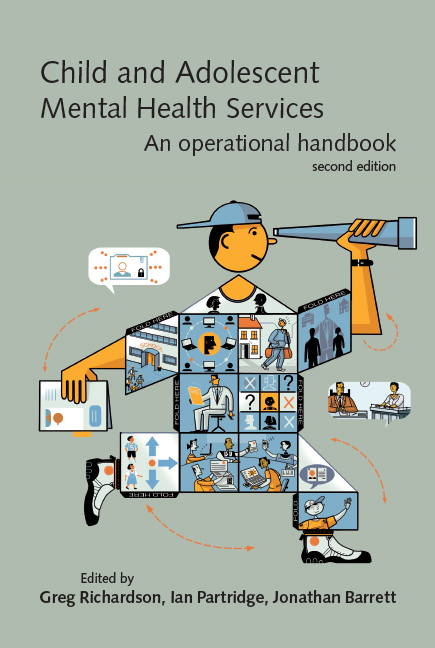Book contents
- Frontmatter
- Contents
- Tables, boxes and figures
- Contributors
- Abbreviations
- Preface
- 1 Introduction
- 2 CAMHS in context
- 3 CAMHS and the law
- 4 Structure, organisation and management of CAMHS
- 5 Evidence-based practice
- 6 Clinical governance
- 7 Education, supervision and workforce development
- 8 Multidisciplinary working
- 9 User and carer participation and advocacy
- 10 A comprehensive CAMHS
- 11 Referral management
- 12 Demand and capacity management
- 13 Strategies for working with Tier 1
- 14 Structuring and managing treatment options
- 15 CAMHS in the emergency department
- 16 Paediatric liaison
- 17 Self-harm
- 18 Learning disability services
- 19 Services for autism-spectrum disorders
- 20 Attentional problems services
- 21 Eating disorder teams
- 22 Bereavement services
- 23 CAMHS for refugees and recent immigrants
- 24 CAMHS and looked-after children
- 25 Drug and alcohol teams
- 26 Parenting risk assessment service
- 27 Court work
- 28 Tier 4 options
- 29 In-patient psychiatric care
- 30 Forensic services
- 31 Neuropsychiatry and neuropsychology services
- 32 Mental health provision for deaf children: study of a low-incidence service provision
- 33 Chief Executives – what do they want and how do they get it?
- Index
13 - Strategies for working with Tier 1
- Frontmatter
- Contents
- Tables, boxes and figures
- Contributors
- Abbreviations
- Preface
- 1 Introduction
- 2 CAMHS in context
- 3 CAMHS and the law
- 4 Structure, organisation and management of CAMHS
- 5 Evidence-based practice
- 6 Clinical governance
- 7 Education, supervision and workforce development
- 8 Multidisciplinary working
- 9 User and carer participation and advocacy
- 10 A comprehensive CAMHS
- 11 Referral management
- 12 Demand and capacity management
- 13 Strategies for working with Tier 1
- 14 Structuring and managing treatment options
- 15 CAMHS in the emergency department
- 16 Paediatric liaison
- 17 Self-harm
- 18 Learning disability services
- 19 Services for autism-spectrum disorders
- 20 Attentional problems services
- 21 Eating disorder teams
- 22 Bereavement services
- 23 CAMHS for refugees and recent immigrants
- 24 CAMHS and looked-after children
- 25 Drug and alcohol teams
- 26 Parenting risk assessment service
- 27 Court work
- 28 Tier 4 options
- 29 In-patient psychiatric care
- 30 Forensic services
- 31 Neuropsychiatry and neuropsychology services
- 32 Mental health provision for deaf children: study of a low-incidence service provision
- 33 Chief Executives – what do they want and how do they get it?
- Index
Summary
‘In the beginning was the word and that word may well have been anxiety.’
Jules MassermanIntroduction
Mental health problems in children are best understood as being affected by and presenting in the children's constitutional functioning and in all areas of their interaction with their environment. Parents, families and teachers have a major role to play in the maintenance of mental health. Professionals such as childminders, teachers, school nurses, educational psychologists, social workers, GPs and health visitors make a substantial contribution to the promotion and maintenance of the mental health of children if they come in contact with them. They also play a role in the early identification of mental health problems, children's vulnerability thereto and in the management of those mental health problems once identified. However, Tier 1 professionals often feel at a loss as to how to manage children's mental health problems and all the emotional baggage that goes with them.
Mental health professionals, who provide a small part of the mental healthcare of children, classify the more serious mental health problems as mental disorders (World Health Organization, 1992). These disorders represent a small proportion of mental health problems produced by constitutional, family, educational, social and environmental factors, illness or developmental delay, all of which may impair future psychological functioning. The epidemiological evidence is that mental disorders affect about 10% of children (Ford et al, 2003), although estimates range from 10 to 20% (Fombonne, 2002). If all those children were referred to CAMHS, the service would be overwhelmed. Child and adolescent mental health services see only about 20% of these children. The alternative of providing support to Tier 1 professionals from primary mental health workers, or other CAMHS professionals ensures:
• children with mental health problems, and their families, are dealt with by those with whom they already have a relationship;
• more children than could be seen by individual mental health professionals have the benefit of mental health expertise;
• increased confidence and expertise among Tier 1 professionals dealing directly with young people and their families (Richardson & Partridge, 2000).
- Type
- Chapter
- Information
- Child and Adolescent Mental Health ServicesAn Operational Handbook, pp. 112 - 126Publisher: Royal College of PsychiatristsFirst published in: 2017



